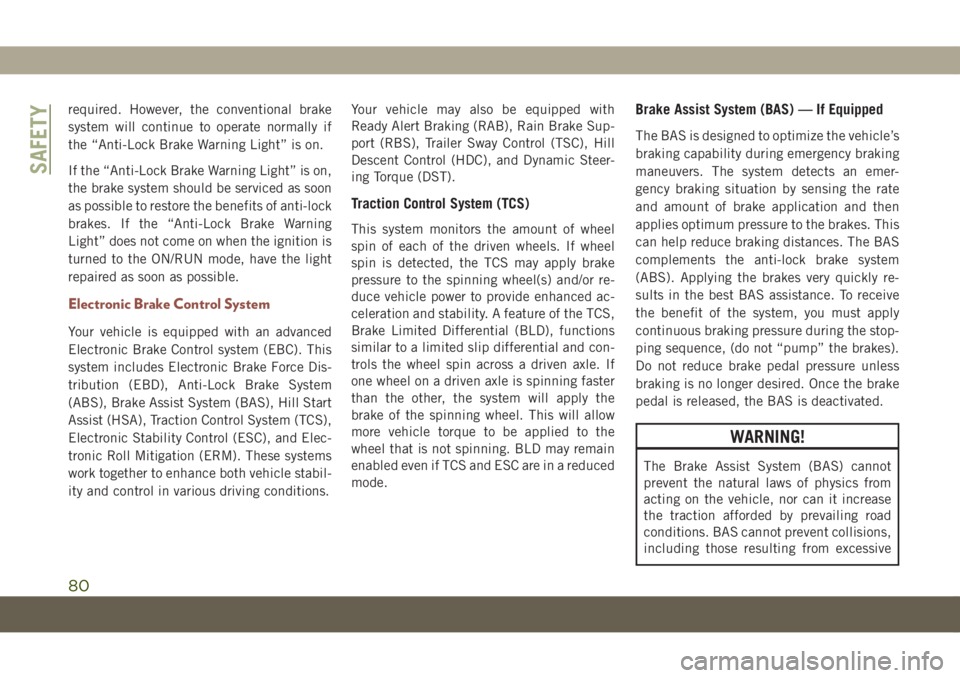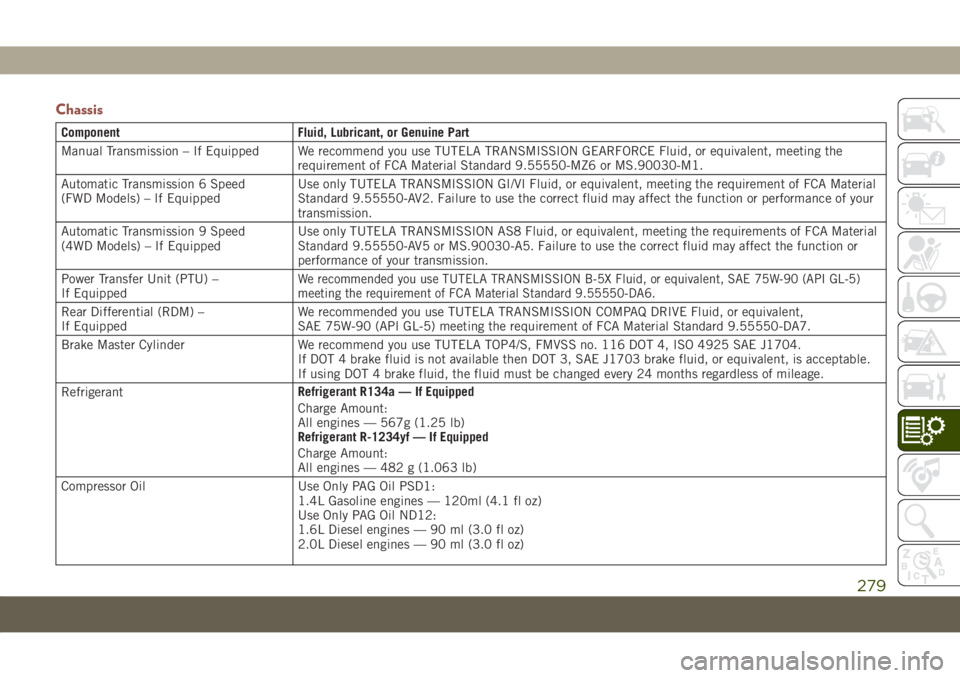differential JEEP COMPASS 2019 Owner handbook (in English)
[x] Cancel search | Manufacturer: JEEP, Model Year: 2019, Model line: COMPASS, Model: JEEP COMPASS 2019Pages: 362, PDF Size: 6.23 MB
Page 82 of 362

required. However, the conventional brake
system will continue to operate normally if
the “Anti-Lock Brake Warning Light” is on.
If the “Anti-Lock Brake Warning Light” is on,
the brake system should be serviced as soon
as possible to restore the benefits of anti-lock
brakes. If the “Anti-Lock Brake Warning
Light” does not come on when the ignition is
turned to the ON/RUN mode, have the light
repaired as soon as possible.
Electronic Brake Control System
Your vehicle is equipped with an advanced
Electronic Brake Control system (EBC). This
system includes Electronic Brake Force Dis-
tribution (EBD), Anti-Lock Brake System
(ABS), Brake Assist System (BAS), Hill Start
Assist (HSA), Traction Control System (TCS),
Electronic Stability Control (ESC), and Elec-
tronic Roll Mitigation (ERM). These systems
work together to enhance both vehicle stabil-
ity and control in various driving conditions.Your vehicle may also be equipped with
Ready Alert Braking (RAB), Rain Brake Sup-
port (RBS), Trailer Sway Control (TSC), Hill
Descent Control (HDC), and Dynamic Steer-
ing Torque (DST).
Traction Control System (TCS)
This system monitors the amount of wheel
spin of each of the driven wheels. If wheel
spin is detected, the TCS may apply brake
pressure to the spinning wheel(s) and/or re-
duce vehicle power to provide enhanced ac-
celeration and stability. A feature of the TCS,
Brake Limited Differential (BLD), functions
similar to a limited slip differential and con-
trols the wheel spin across a driven axle. If
one wheel on a driven axle is spinning faster
than the other, the system will apply the
brake of the spinning wheel. This will allow
more vehicle torque to be applied to the
wheel that is not spinning. BLD may remain
enabled even if TCS and ESC are in a reduced
mode.
Brake Assist System (BAS) — If Equipped
The BAS is designed to optimize the vehicle’s
braking capability during emergency braking
maneuvers. The system detects an emer-
gency braking situation by sensing the rate
and amount of brake application and then
applies optimum pressure to the brakes. This
can help reduce braking distances. The BAS
complements the anti-lock brake system
(ABS). Applying the brakes very quickly re-
sults in the best BAS assistance. To receive
the benefit of the system, you must apply
continuous braking pressure during the stop-
ping sequence, (do not “pump” the brakes).
Do not reduce brake pedal pressure unless
braking is no longer desired. Once the brake
pedal is released, the BAS is deactivated.
WARNING!
The Brake Assist System (BAS) cannot
prevent the natural laws of physics from
acting on the vehicle, nor can it increase
the traction afforded by prevailing road
conditions. BAS cannot prevent collisions,
including those resulting from excessive
SAFETY
80
Page 268 of 362

Minimum Ground Clearance (Reference A)
The clearance value is measured next to the
lower edge of the differential. This value also
defines those for the “Approach Angle” the
“Departure Angle” and the “Breakover Angle”.
Dimensions are expressed in inches (mm)
and refer to the vehicle equipped with its
original tires.
Approach Angle (Reference B)
The approach angle is determined by the
horizontal line of the road surface, and by the
tangent line passing between the front wheel,
and the most projecting low point of the car.
The wider the angle, the lower the chance to
hit an obstacle with the body or chassis,
when climbing a steep slope or overcoming
an obstacle.
Departure Angle (Reference C)
The departure angle is determined by the
same lines of the “Approach Angle”, and
refers to the rear part of the vehicle.Breakover Angle (Reference D)
The value of the “Breakover Angle” is linked
to the ground clearance of the vehicle and
indicates the attitude of the vehicle to over-
come a wedge, more or less steep, preventing
the vehicle from resting on the ground with
the body or chassis after touching the wedge
with its lowest and most projecting parts
(usually the underbody), because this would
highly reduce wheel grip.
The wheels, without a suitable grip to the
ground, will not have sufficient hold to move
the vehicle, and will surge.
The higher the ground clearance, the wider
the breakover angle. Always bear in mind that
the higher the ground clearance, the lower
the stability, due to a higher center of gravity
which reduces the side rollover angle.Ground Clearance / Typical Angles
Measurements
TECHNICAL SPECIFICATIONS
266
Page 281 of 362

Chassis
Component Fluid, Lubricant, or Genuine Part
Manual Transmission – If Equipped We recommend you use TUTELA TRANSMISSION GEARFORCE Fluid, or equivalent, meeting the
requirement of FCA Material Standard 9.55550-MZ6 or MS.90030-M1.
Automatic Transmission 6 Speed
(FWD Models) – If EquippedUse only TUTELA TRANSMISSION GI/VI Fluid, or equivalent, meeting the requirement of FCA Material
Standard 9.55550-AV2. Failure to use the correct fluid may affect the function or performance of your
transmission.
Automatic Transmission 9 Speed
(4WD Models) – If EquippedUse only TUTELA TRANSMISSION AS8 Fluid, or equivalent, meeting the requirements of FCA Material
Standard 9.55550-AV5 or MS.90030-A5. Failure to use the correct fluid may affect the function or
performance of your transmission.
Power Transfer Unit (PTU) –
If Equipped
We recommended you use TUTELA TRANSMISSION B-5X Fluid, or equivalent, SAE 75W-90 (API GL-5)
meeting the requirement of FCA Material Standard 9.55550-DA6.
Rear Differential (RDM) –
If EquippedWe recommended you use TUTELA TRANSMISSION COMPAQ DRIVE Fluid, or equivalent,
SAE 75W-90 (API GL-5) meeting the requirement of FCA Material Standard 9.55550-DA7.
Brake Master Cylinder We recommend you use TUTELA TOP4/S, FMVSS no. 116 DOT 4, ISO 4925 SAE J1704.
If DOT 4 brake fluid is not available then DOT 3, SAE J1703 brake fluid, or equivalent, is acceptable.
If using DOT 4 brake fluid, the fluid must be changed every 24 months regardless of mileage.
RefrigerantRefrigerant R134a — If Equipped
Charge Amount:
All engines — 567g (1.25 lb)
Refrigerant R-1234yf — If Equipped
Charge Amount:
All engines — 482 g (1.063 lb)
Compressor Oil Use Only PAG Oil PSD1:
1.4L Gasoline engines — 120ml (4.1 fl oz)
Use Only PAG Oil ND12:
1.6L Diesel engines — 90 ml (3.0 fl oz)
2.0L Diesel engines — 90 ml (3.0 fl oz)
279